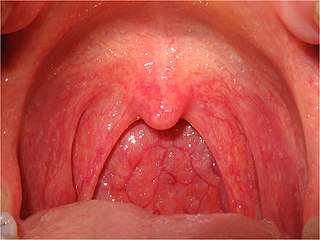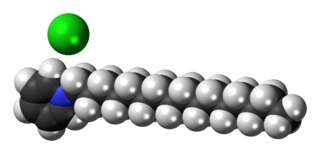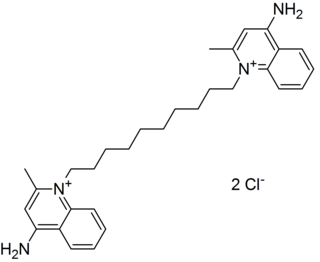
Mouthwash, mouth rinse, oral rinse, or mouth bath is a liquid which is held in the mouth passively or swilled around the mouth by contraction of the perioral muscles and/or movement of the head, and may be gargled, where the head is tilted back and the liquid bubbled at the back of the mouth.

Candidiasis is a fungal infection due to any type of Candida. When it affects the mouth, in some countries it is commonly called thrush. Signs and symptoms include white patches on the tongue or other areas of the mouth and throat. Other symptoms may include soreness and problems swallowing. When it affects the vagina, it may be referred to as a yeast infection or thrush. Signs and symptoms include genital itching, burning, and sometimes a white "cottage cheese-like" discharge from the vagina. Yeast infections of the penis are less common and typically present with an itchy rash. Very rarely, yeast infections may become invasive, spreading to other parts of the body. This may result in fevers along with other symptoms depending on the parts involved.

Pharyngitis is inflammation of the back of the throat, known as the pharynx. It typically results in a sore throat and fever. Other symptoms may include a runny nose, cough, headache, difficulty swallowing, swollen lymph nodes, and a hoarse voice. Symptoms usually last 3–5 days, but can be longer depending on cause. Complications can include sinusitis and acute otitis media. Pharyngitis is a type of upper respiratory tract infection.

Sore throat, also known as throat pain, is pain or irritation of the throat. Usually, causes of sore throat include:

Benzocaine, sold under the brand name Orajel amongst others, is an ester local anesthetic commonly used as a topical pain reliever or in cough drops. It is the active ingredient in many over-the-counter anesthetic ointments such as products for oral ulcers. It is also combined with antipyrine to form A/B otic drops to relieve ear pain and remove earwax. In the US, products containing benzocaine for oral application are contraindicated in children younger than two years old. In the European Union, the contraindication applies to children under 12 years of age.
Breath spray is a product sprayed into the mouth for the purpose of temporarily eliminating or at least covering up bad breath. The masking effect is short-term and reported to last for 4-6 hours. Breath sprays are occasionally advertised as being for smokers or those who dip tobacco, and occasionally to cover up the smell of cigarette/cigar smoking. Common flavours include cinnamon, spearmint and peppermint, as well as company-specific flavors, such as "Ice Mint", "Cool Mint" or "Supermint".
A complication in medicine, or medical complication, is an unfavorable result of a disease, health condition, or treatment. Complications may adversely affect the prognosis, or outcome, of a disease. Complications generally involve a worsening in severity of disease or the development of new signs, symptoms, or pathological changes which may become widespread throughout the body and affect other organ systems. Thus, complications may lead to the development of new diseases resulting from a previously existing disease. Complications may also arise as a result of various treatments.

Cepacol is an American brand of personal hygiene products, as well as for relief of sore throat. It is distributed in the US by Reckitt. The brand was originally owned by J.B. Williams. Following acquisition by Combe Incorporated, Combe Incorporated sold Cepacol to Reckitt Benckiser in 2011.

Olopatadine, sold under the brand name Opatanol among others, is a medication used to decrease the symptoms of allergic conjunctivitis and allergic rhinitis. It is used as eye drops or as a nasal spray. The eye drops generally result in an improvement within half an hour.

TCP is a mild antiseptic, produced in France by Laboratoires Chemineau in Vouvray and sold in the United Kingdom by Omega Pharma.

Cefdinir, sold under the brand name Omnicef among others, is an antibiotic used to treat pneumonia, otitis media, strep throat, and cellulitis. It is a less preferred option for pneumonia, otitis media, and strep throat which may be used in those with a severe allergy to penicillin. It is taken by mouth.

Strepsils is a brand of throat lozenges manufactured by Reckitt. Strepsils throat lozenges are used to relieve discomfort caused by mouth and throat infections.

Cetylpyridinium chloride (CPC) is a cationic quaternary ammonium compound used in some types of mouthwashes, toothpastes, lozenges, throat sprays, breath sprays, and nasal sprays. It is an antiseptic that kills bacteria and other microorganisms. It has been shown to be effective in preventing dental plaque and reducing gingivitis. It has also been used as an ingredient in certain pesticides. Though one study seems to indicate cetylpyridinium chloride does not cause brown tooth stains, at least one mouthwash containing CPC as an active ingredient bears the warning label "In some cases, antimicrobial rinses may cause surface staining to teeth," following a failed class-action lawsuit brought by customers whose teeth were stained.

Benzydamine, available as the hydrochloride salt, is a locally acting nonsteroidal anti-inflammatory drug (NSAID) with local anaesthetic and analgesic properties for pain relief and anti-inflammatory treatment of inflammatory conditions of the mouth and throat. It falls under class of chemicals known as indazole.

Amylmetacresol (AMC) is an antiseptic used to treat infections of the mouth and throat. It is used as an active pharmaceutical ingredient in Strepsils, Cēpacol, Gorpils and Lorsept throat lozenges, typically in combination with dichlorobenzyl alcohol, another antiseptic.

Dequalinium is a quaternary ammonium cation and bolaamphiphile commonly available as the dichloride salt. It is useful as an antiseptic and disinfectant. The bromide, iodide, acetate, and undecenoate salts are known as well. Dequalinium chloride is the active ingredient of several medications.

Savlon is a brand of antibacterial personal care products with the active ingredients of cetrimide and chlorhexidine gluconate. Commonly sold as a cream, the product range also includes antiseptic sprays, sticking plasters and other antiseptic products.

Clotrimazole, sold under the brand name Lotrimin, among others, is an antifungal medication. It is used to treat vaginal yeast infections, oral thrush, diaper rash, tinea versicolor, and types of ringworm including athlete's foot and jock itch. It can be taken by mouth or applied as a cream to the skin or in the vagina.
Decolonization, also bacterial decolonization, is a medical intervention that attempts to rid a patient of an antimicrobial resistant pathogen, such as methicillin-resistant Staphylococcus aureus (MRSA) or antifungal-resistant Candida.
Parodontax is a brand name of toothpaste and mouthwash currently owned by Haleon, previously GSK.
















